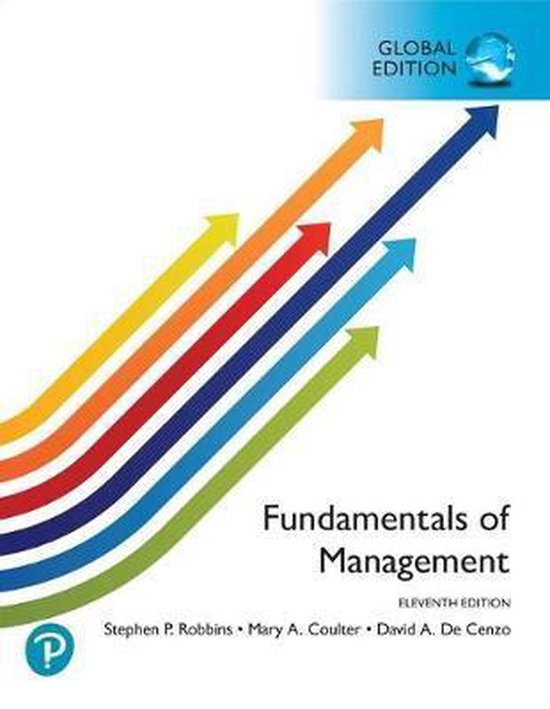Lecture 6 september: Chapter 1
Organization: a systematic arrangement of people brought together to accomplish some
specific purpose.
Three characteristics of an organization:
- It has a distinct purpose (goal or set of goals)
- People in an organization work to achieve goals
- An organization is structured in some way that defines and limits the behavior of its
members
An organization can have different goals:
- Winst (profit)
- ‘Brood op de plank’ loon voor zichzelf
- Werkgelegenheid (employment opportunities)
- Maatschappelijk belang (social importance)
De levensverwachting van een bedrijf is iets meer dan 20 jaar. Zelfs de fortune 500 bedrijven
hebben vaak geen levenslange levensduur (overname)
Soorten bedrijven
- Geen rechtspersoon (zijn zelfverantwoordelijk voor schulden van een bedrijf)
o Eenmanszaak
o Vennootschap onder firma (VOF)
o Maatschap
o Commanditaire (stille) Vennootschap de stille vennoot maakt geen
beslissingen
- Rechtspersoon (beschermt de individuen bedrijven kunnen meer risico nemen)
o Besloten Vennootschap (BV)
o Naamloze Vennootschap (NV) (raad van bestuur en toezicht)
Coöperatie
o Vereniging
o Stichting
Nonmanagerial employees: people who work directly on a job or task and have no
responsibility for overseeing the work for others.
Managers: individuals in an organization who direct and oversee the activities of other
people in the organization so organizational goals can be accomplished.
Top managers (president): individuals who are responsible for making decisions about the
direction of the organization and establishing policies that affect all organizational members.
Middle managers (store manager): individuals who are typically responsible for translating
goals set by top managers into specific details that lower-level managers will see get done
First-line managers (department managers): supervisors responsible for directing the day-to-
day activities of nonmanagerial employees.
Team leaders: individuals who are responsible for managing and facilitating the activities of a
work team.
,Management: the process of getting things done, effectively and efficiently, through and
with other people.
Efficiency: doing a task correctly and getting the most output from the least amount of
inputs (doing things right)
Effectiveness: completing important activities (doing the right things)
4 functions approach:
Planning: defining goals, establishing strategy, coordinating
Organizing: determining what tasks are to be done, how it will be done, and who is to do it
Leading: motivating and communicating with employees, and directing them employees
Controlling: monitoring performance, correcting deviations
Management roles approach: Henry Mintzberg said managers have specific categories of
managerial actions or behaviors
Skills and competencies four general management skills:
Conceptual: analyze and diagnose complex situations
Interpersonal: working well with other people both individually and in groups by
communicating, motivating, mentoring and delegating
Technical: job-specific knowledge, expertise, and techniques needed to perform work tasks.
Political: building a power base and establishing the right connections
Goede managers zijn schaars, waarom?
- Goede professionals zijn niet per se goed managers
- Het is lastig voor managers om over te stappen
Small business: an independent business having fewer than 500 employees that doesn’t
necessarily engage in any new or innovative practices and has relatively little impact on its
industry.
The most important roll of a manager in a small business is that of a spokesperson, however
the most important concerns of a manager in a large organization are directed internally.
Customers, innovation, social media and sustainability are important changes to
organizations and managers everywhere.
First focusing on the customers was the responsibility of the marketers, however we’re
discovering that employee attitudes and behaviors play a big role in customer satisfaction.
Sustainability: a company’s ability to achieve its business goals and increase long-term
shareholder value by integrating economic, environmental, and social opportunities into its
business strategies.
Employee engagement: when employees are connected to, satisfied with, enthusiastic about
their jobs. The relationship between employees and their direct supervisors is the largest
factor in employee engagement
, Hoe je moet managen begon bij Adam Smit’s pin factory, hij zei dat men zich moest gaan
specialiseren (devision of labor)
Smith ging er van uit dat mensen rationeel dachten dus hij legde de nadruk op rationaliteit
en efficiency.
Klassieke benadering
Taylor’s scientific management:
- Taken meten, efficiëntie bijhouden
- Selecteren van de juiste persoon voor een baan, train hen op wetenschappelijke
wijze om iets precies zoals voorgeschreven te doen
- Management en operationeel scheiden
- Werknemers motiveren door loon (extrinsieke motivatie)
Gilbreth’s scientific management:
- Meet bewegingen (maakte gebruik van film om werknemers te observeren)
Fayol’s 14 principles
- Specialisatie en autoriteit, centralisatie, eenheid van leiding en één richting voor het
bedrijf (bedrijfsbelang boven persoonlijk)
Weber bureaucratie (uniforme regels voor alle werknemers)
- Division of labor (specialization of labor)
- Authority hierarchy
Kwantitieve benaderingen:
Statistieken, optimalisatiemodellen, informatiemodellen (total quality management ->
continue verbetering, reageer op klantenwensen)
De nadruk bij managers ligt tegenwoordig op cultuur, motivatie, strategisch management,
HR, leiderschap, vertrouwen, communicatie, kennis uitwisselen, maar ook op plannen en
kwaliteit.
Dilemma’s voor managers:
Belangen en doelen (missies, visies) binnen een bedrijf kunnen verschillen
Pincipal-agency theory (intrinsieke of extrinsieke motivatie bij werknemers)
Individu vs Bedrijf
Afdeling vs Bedrijf
Dochterbedrijf vs Headquarters
Centralisatie of toch delegatie
Kiezen voor kosten, kwaliteit of klanttevredenheid. (Het focussen op kosten gaat ten
koste van de kwaliteit en een mindere kwaliteit gaat ten koste van de
klanttevredenheid.)
Bedrijf vs. Samenleving maatschappelijk verantwoord ondernemen. Bedrijven hebben
bijvoorbeeld effect op het milieu. Weet de overheid wel genoeg over ondernemingen, zo
niet dan gaat het ten koste van de economische dynamiek.






